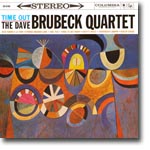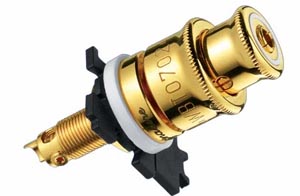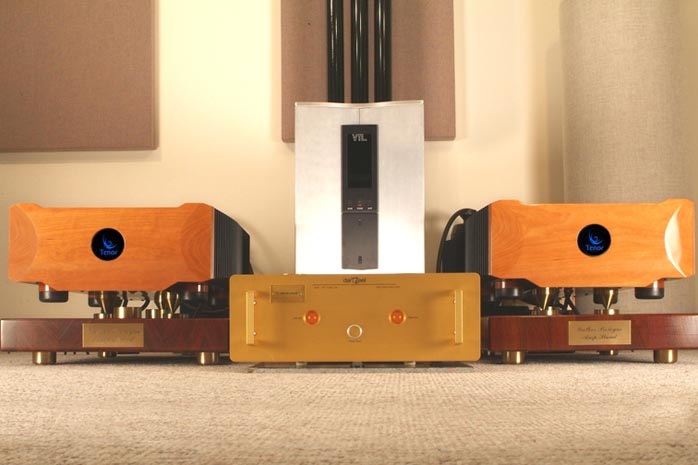|
This review page is supported in part by the sponsor whose ad is displayed above
|
||||||||||||||||||||
 |
||||||||||||||||||||
| Frequency Response As you step through the response range, there is only one appropriate word - flawless. Highs sparkle with life; open, pure, clean and defined. To me the treble extension and detail help define the air; that individual space around an instrument that gives depth and 3-D realism. Don't confuse extended pure treble with a cold white treble that actually diminishes total color. The 350Ms' response is to 200K with a grain-free purity that is completely devoid of electronic artefacts. Just listen to the soaring highs of Beethoven's Violin Concerto in D, [Heifetz, Boston Symphony Orchestra, RCA LSC-1992] with the violin shimmering in the room. It's serious goose-bump territory. The all-important midrange is equally as good, both rich and harmonic. You could almost swim through its liquidity yet there isn't even a hint of thickness, loss of detail or an overly romantic tube glaze. |
||||||||||||||||||||
 |
||||||||||||||||||||
| At one time or another we've all heard wonderful midrange and treble detail textures but as you move down in frequency response, the subtle details often meld together into a homogeneous singularity. What if you could have the detail and subtlety of the finest midrange throughout the entire musical spectrum? Imagine if you could hear the same shadings heard at the most intimate levels of midrange and treble but translated to the low end and with all the authority of an unlimited well of power? This is the low end of a Tenor. Many consider the big-time mainstream amps such as Krell, Levinson, Halcro and a few others to be the final word on iron-fisted bass response and control. Yes, these amps plumb the depths and are the antithesis of bloaty, flabby or loose. As a former owner of Krell and Levinson, I can tell you that now there's a new sheriff in town. The Tenors bring everything these amps have at the bottom and add to it glorious dynamic shadings and textures. The room-shaking power is there - deeper and more forceful than I've ever heard. But the real difference is the subtleties that others only hint at yet which the 350Ms develop. |
||||||||||||||||||||
| Try Ray Brown, acknowledged master of the double bass. His Soular Energy [Audiophile Master Records PA-002] contains a ton of low-end power. I've heard this record sound loud, flabby, compressed and everything in between. Until you've heard it though the 350Ms, I'll bet you never heard its power combined with subtle detail. Just close your eyes and you'll swear you see his fingers sliding on and off the strings. The entire recording through the Tenors is full of a low-end vitality and color, full, deep and rich without a touch of bloat. |
||||||||||||||||||||
 |
||||||||||||||||||||
| If you want a real treat, pull out your favorite pressing of Take Five. In my case it is the 45rpm Classic reissue. The drums are | ||||||||||||||||||||
 |
||||||||||||||||||||
| presented with speed and power, without the slightest hint of leading edge blur yet with superior transient response, visceral power and natural decay. Wow, that sounds just like a definition of a drum in real space. |
||||||||||||||||||||
| Soundstage | ||||||||||||||||||||
| The finest soundstage I've ever heard, period, end of story, not even close. It's deep, layered and holographic. Yep, I am a soundstaging freak. I love to be immersed but properly scaled | ||||||||||||||||||||
| relative to the music. I tend toward equipment that projects the soundstage in front of the speakers. The Tenors scale the soundstage and present it more accurately, I believe, than any other amplifier in my experience. It's just there, realistically. Alison Krauss and Robert Plant make a duo that probably wouldn't make your top 10 groupings, probably not even your top 1000. Their new album Raising Sand [Rounder Records] is not really a duet but more a collaboration of some very interesting and unusual tracks, definitely not mainstream pop, rock, blues or country. It's almost an undefined crossover genre with many influences. The Tenors place both tonally rich voices focused sharply about six foot high and directly between the speakers in a naturally reverberant sound field. |
||||||||||||||||||||
| Holly Cole's Temptation "Invitation to the Blues" [Blue Note JP5003] displays a massive wraparound soundstage with her pinpoint airy voice coming deeply from the chest with full-bodied range. The pinpoint description is quite appropriate as it is utterly stable. Generally, voices and instruments grow larger as the volume increases and we've all heard ten-foot wide singing heads. Yet with the Tenors, the image did not shift, wander, grow or shrink as the volume changed. |
||||||||||||||||||||
 |
||||||||||||||||||||
| The Tenors give a very interesting musical perspective. With most other components, the music is lit in the mind's eye from spotlights shining onto and illuminating the soundstage. | ||||||||||||||||||||
| The Tenors' presentation of music is more from a light within, allowing each instrument to develop its own color and tone. It's not spotlighting but emanates deep from inside the music even though this effect does not happen with every recording. You need a well-recorded piece to really show off the effect. The 350Ms present a somewhat forward perspective. Generally the depth of presentation either starts at the speaker face and projects backward or starts slightly behind the speaker face and projects forward. I found that the box size is similar in many cases but it is just shifted or moved depending upon the design goals of the amplifier. Overall the Tenors have a forward projection, immersing the listener when appropriate but I've also noticed a solid depth behind the speakers' back, allowing the listener to hear deep within the layers of music. Depending upon the source material, it's pretty uncanny. |
||||||||||||||||||||
| Comparisons On a dollar for dollar basis, the comparison between the Tenor, darTZeel 108 and VTL S-400 is certainly not fair. Yet each in their own way is the flagship model of their company and a definitive statement on what is possible in amplification. Actually, the VTL S-400 is not the top of the line but does share much with its big-brother Siegfrieds and has a very similar sonic fingerprint. All three amps have their own unique approach using three designs: pure tube, pure solid-state and OTL hybrid. |
 |
|||||||||||||||||||
| Staying with this comparison, the Tenors are like a darTZeel on steroids. (Good steroids, not those harmful illegal ones.) The qualities of purity, resolution and transparency that make darTZeel a | ||||||||||||||||||||
| world-class amp are raised up a notch or two with the Tenors. If you like the sonic presentation the 'darts brings to the table, you'll be ecstatic with the 350Ms. There's a lot in the basic foundation that is similar but Tenor takes it to another level and they should based on the price differential. The biggest differences are ultimate power, dynamics and bass. Don't forget that I am comparing a 100-watt darTZeel that is happiest at 8 ohms with a 350-watt monster that will effectively double power down to 2 ohms. It's interesting; you get into a comfort zone with your reference amp. Unless the amp has glaring errors, which few do at this level, their performance eventually becomes normal to you. With the efficient Wilson X-2s, I never found the darTZeel wanting in the low end and for its power rating, it has an articulate and well-defined bottom. When you compare it to the Tenors with their seemingly infinite capacity and reserves, low-end bass definition takes on a whole new meaning. The low-end difference between the Tenors and the darTZeel is significant. |
||||||||||||||||||||
 |
||||||||||||||||||||
The VTL has power to spare but doesn't quite meet the highest levels of transparency and refinement of the Tenors. The Tenors' clarity and air around the individual instruments give them an edge in resolution and ability to see the instruments. Don't take these comparisons negatively for either competitor is among a handful of the best. Until a few months ago, I was the happiest listener on the planet with the ability to switch between the darTZeel and VTL. Tenor has simply raised the bar. Summary When you find a company that possibly redefines a genre, how do you write an objective review without sounding like their marketing department? What happens if in an effort to be fair and balanced, there is no major negative offset to report except for price? I do understand that nothing is perfect but this is a darn near perfect amp. |
||||||||||||||||||||
| There will be few able to afford these amplifiers and that's a shame. However, for all who love music, go out of your way to listen to these. Track them down at a show, a dealer or even hop up to Montréal. Having personally reached the ecstasy of audio nirvana with darTZeel and VTL, in came the 350Ms and moved audio amplification to another level, albeit at a stratospheric price. Damn you, Tenor. The problem is that you can't un-ring a bell. Hearing the Tenors in a long-term reference configuration, there can be only one conclusion - a new standard has been set. Yet there is hope on the horizon. A 175-watt stereo version is in | ||||||||||||||||||||
 |
||||||||||||||||||||
 |
||||||||||||||||||||
| the works and will bring the Tenor sound to a more affordable stratum, if not the masses. Hopefully the technology will eventually trickle down farther into a more affordable mainstream product. | ||||||||||||||||||||
An extraordinary accomplishment! |
||||||||||||||||||||
 |
||||||||||||||||||||
Quality of packing: Custom aluminum shipping cases; padded interior; special linen amp cover - beyond outstanding. Reusability of packing: Lifetime reusable Ease of unpacking/repacking: Very easy. The top of the shipping crate opens into two sections giving easy access to the amp. Condition of component received: Flawless. Completeness of delivery: Included power cable and draft manual. Production units will include an accessory kit with fuses and hex key tool. Quality of owner's manual: I received the draft operations manual. Although the draft copy did not have the final pictures, at twenty pages it is complete and informative. Website comments: Under construction. As of this review, only a single introductory homepage was available. Warranty: "Tenor Inc. warrants the Tenor 350M to be free from defects in materials or workmanship for a period of 5 years from the date of the original purchase provided the amplifier is registered with a valid proof of purchase at the time of purchase. Vacuum tubes are guaranteed for 10,000 hours or 5 years from the original purchase date - whichever comes first. Should the Tenor 350M be defective during the warranty period, Tenor Inc. elects at its sole discretion to either repair or replace the unit free of charge." Global distribution: Company manufactures in Montreal Canada and is in the process of developing international distribution. Human interactions: Exceptional helpful and courteous. I spent three days in their facility and was offered outstanding access. All questions were answered promptly and professionally. Other: For those wishing to hear the sate-of the art, the 350MMs are a 'must listen'. Pricing: The best does not come cheap. Application conditions: 20amp circuit recommended. Final comments & suggestions: None. |
||||||||||||||||||||
 |
||||||||||||||||||||
 |
||||||||||||||||||||
|
Manufacturer's website
|
||||||||||||||||||||
 |
||||||||||||||||||||